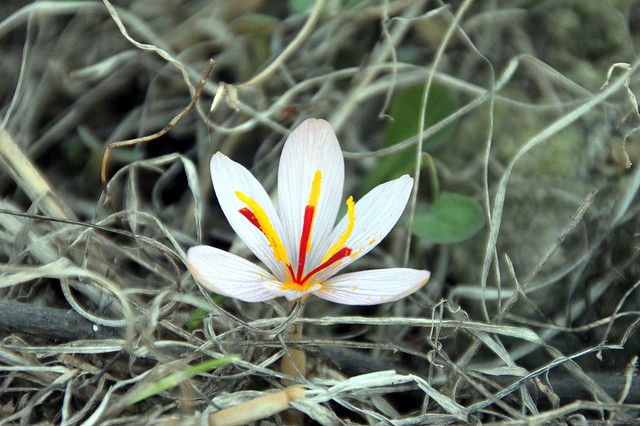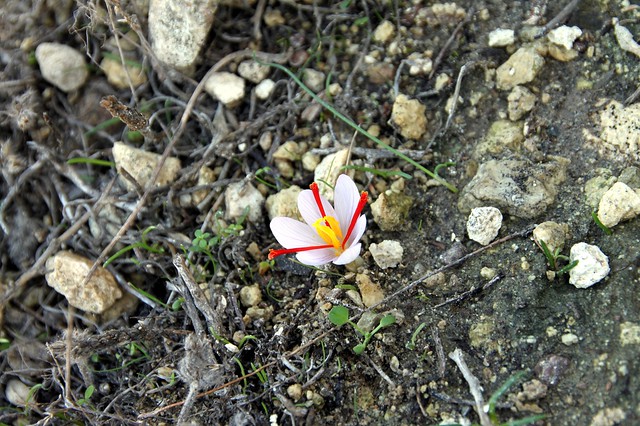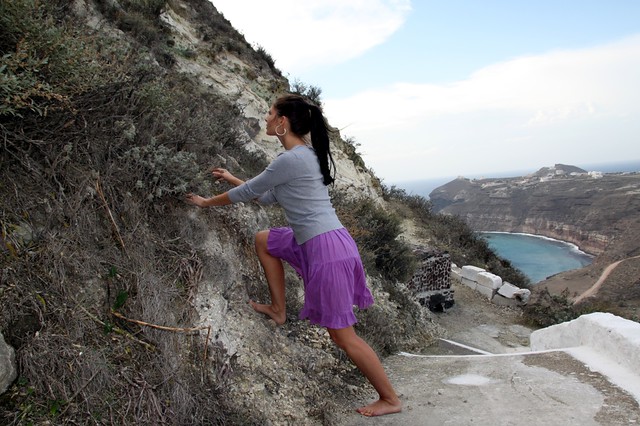

Είναι εδώ, σε αυτό το νησί χιλιάδες χρόνια... Επιβίωσε όταν ο άνθρωπος δεν τα κατάφερε... Ο κρόκος...
Από την στιγμή που έμαθα ότι ο κρόκος εξακολουθεί να ανθίζει τον Νοέμβριο, σε ορισμένα σημεία της Σαντορίνης, το είχα συνέχεια στο μυαλό μου... Περίμενα πως και πως... Από τις αρχές του μήνα πήγαινα στον λόφο του Ταξιάρχη, στο Ακρωτήρι, σχεδόν καθημερινά... Μου είπαν "ανθίζει μετά του Ταξιάρχη". Έβαλα, λοιπόν, σκοπό να πάω αυτό το Σάββατο... Μου είπαν "θέλει ήλιο για να ανθίσει"... Απογοητεύτηκα όταν η πρόγνωση του καιρού έδινε καταιγίδα για σήμερα... Ξύπνησα στις 5 το πρωί και ο καιρός ήταν πράγματι κακός... Το ίδιο και στις 6 και στις 7... Στις 11 τα πράγματα ήταν λίγο καλύτερα... Ντύθηκα, πήρα την φωτογραφική μου μηχανή και έφυγα για τον Ταξιάρχη... Για μία ώρα δεν βρήκα τίποτα... Περπάτησα όλον τον λόφο από τα ανατολικά... Περπάτησα και τον επόμενο... Παντού το μικρό κολχικό, αλλά πουθενά κρόκος... Βγήκε κι ο ήλιος, αλλά η τύχη μου δεν άλλαξε... Τότε θυμήθηκα την κυρά Άννα, η οποία μου είπε, "την μέρα του Ταξιάρχη, η μάνα μου είδε έναν κρόκο δίπλα στην εκκλησία και μας το έδειξε"...
Πήγα κοντά στην εκκλησία... Ήταν εκεί! Δεν ξέρω, ήταν ίσως η προσμονή να το δω... Η αίσθηση ότι είναι η ζωντανή συνέχεια της προεκρηξιακής Θήρας... Ανατρίχιασα... Αισθάνθηκα δέος! Ευλογημένος... Ήταν πανέμορφο... Πιο όμορφο από ό,τι περίμενα...
Από την στιγμή που έμαθα ότι ο κρόκος εξακολουθεί να ανθίζει τον Νοέμβριο, σε ορισμένα σημεία της Σαντορίνης, το είχα συνέχεια στο μυαλό μου... Περίμενα πως και πως... Από τις αρχές του μήνα πήγαινα στον λόφο του Ταξιάρχη, στο Ακρωτήρι, σχεδόν καθημερινά... Μου είπαν "ανθίζει μετά του Ταξιάρχη". Έβαλα, λοιπόν, σκοπό να πάω αυτό το Σάββατο... Μου είπαν "θέλει ήλιο για να ανθίσει"... Απογοητεύτηκα όταν η πρόγνωση του καιρού έδινε καταιγίδα για σήμερα... Ξύπνησα στις 5 το πρωί και ο καιρός ήταν πράγματι κακός... Το ίδιο και στις 6 και στις 7... Στις 11 τα πράγματα ήταν λίγο καλύτερα... Ντύθηκα, πήρα την φωτογραφική μου μηχανή και έφυγα για τον Ταξιάρχη... Για μία ώρα δεν βρήκα τίποτα... Περπάτησα όλον τον λόφο από τα ανατολικά... Περπάτησα και τον επόμενο... Παντού το μικρό κολχικό, αλλά πουθενά κρόκος... Βγήκε κι ο ήλιος, αλλά η τύχη μου δεν άλλαξε... Τότε θυμήθηκα την κυρά Άννα, η οποία μου είπε, "την μέρα του Ταξιάρχη, η μάνα μου είδε έναν κρόκο δίπλα στην εκκλησία και μας το έδειξε"...
Πήγα κοντά στην εκκλησία... Ήταν εκεί! Δεν ξέρω, ήταν ίσως η προσμονή να το δω... Η αίσθηση ότι είναι η ζωντανή συνέχεια της προεκρηξιακής Θήρας... Ανατρίχιασα... Αισθάνθηκα δέος! Ευλογημένος... Ήταν πανέμορφο... Πιο όμορφο από ό,τι περίμενα...

Ενθαρρυμένος, άρχισα να ανεβαίνω την δυτική πλευρά του Ταξιάρχη... Βρήκα άλλο ένα... και μετά κι άλλο... κι ένα μπουμπούκι... Κι άρχισα να τον ανακαλύπτω παντού γύρω μου...

Δεν μου κάνει, πλέον, καμία εντύπωση γιατί ο κρόκος συνδέεται με την θρησκεία του Προϊστορικού οικισμού του Ακρωτηρίου... Οι περίφημες τοιχογραφίες με τις κροκοσυλλέκτριες βρέθηκαν στο κτίριο, το οποίο, σήμερα, εμείς έχουμε βαφτίσει ως "Ξεστή 3". "Ξεστή" γιατί είναι κτισμένο από ξεστές (λαξευτές) πέτρες... Ό,τι έχουμε βρεί εκεί μέσα, μας οδηγεί στο συμπέρασμα ότι στο κτίριο γίνονταν τελετές μύησης, οι οποίες πιθανώς να σχετίζονται με την ενηλικίωση των ατόμων... Πρέπει να ήταν ένα πολύ εντυπωσιακό οικοδόμημα, καθώς είχε τουλάχιστον τρεις ορόφους... Πολύ πιθανόν κάθε όροφος να σχετίζεται με κάποιο επίπεδο μύησης... Η τοιχογραφική σύνθεση με τις κροκοσυλλέκτριες βρισκόταν σε ανατολικό τοίχο του πρώτου όροφου... Στην ίδια θεματική ενότητα, στο βόρειο τοίχο του ίδιου δωματίου, ανήκει η μοναδική τοιχογραφία που εμφανίζει θεότητα... Η "Πότνια θηρών" (Δέσποινα των ζώων), η οποία, καθισμένη σε βαθμιδωτό θρόνο, δέχεται την προσφορά των κρόκκων από κροκοσυλλέκτρια που αδειάζει τα καλάθι της σε ένα πανέρι που βρίσκεται μπροστά της. Δίπλα στην Πότνια θηρών βρίσκεται ένας γρύπας, ενώ μπροστά της ένας κυανοπίθηκος.

Αυθαίρετα σκέφτομαι ότι, αν στο ισόγειο είναι το πρώτο επίπεδο μύησης, και στο δεύτερο, μυημένος πλέον, σου επιτρέπεται να δεις και να προσφέρεις στην θεότητα, τότε το τρίτο επίπεδο, ακολουθώντας το μοτίβο κάθε θρησκείας πάνω σε αυτόν τον πλανήτη, θα πρέπει να αντιπροσωπεύει την "υπόσχεση"... Αυτό που η θεότητα θα προσφέρει σε σένα για τις υπηρεσίες σου... Στον δεύτερο όροφο βρέθηκε, λοιπόν, η μεγαλύτερη, μέχρι σήμερα, τοιχογραφία που ανακαλύφθηκε στο Ακρωτήρι... Η Τοιχογραφία με τις πολύχρωμες Σπείρες... Το Σύμπαν; Οι ελιγμοί της σπείρας είναι άπειροι γύρω από το κέντρο της... Η Αθανασία;
Ίσως το "κλειδί του μυστηρίου" να είναι η Τοιχογραφία με τις Λατρεύτριες, στο ισόγειο του κτιρίου, στον βόρειο τοίχο του δωματίου με την δεξαμενή καθαρμών... Τρεις γυναικείες μορφές... Στα δεξιά, η νεαρή εκπαιδευόμενη... Στο μέσο, μια κροκοσυλλέκτρια κάθεται πάνω σε ένα βράχο κρατώντας με το ένα χέρι το τραυματισμένο πόδι της και με το άλλο χέρι το μέτωπό της... Οι κόποι της επίγειας ζωής; Στα αριστερά, γυναικεία μορφή φορά διαφανές μπούστο υψηλής ποιότητας και κρατάει στο χέρι της ένα κομπολόι ή, για άλλους, ένα γιρλάντα λαιμού...
Σημείωση: Ο κρόκος της Σαντορίνης είναι το είδος Crocus Cartwrightianus (Κρόκος ο Καρτβριτάνειος), ο οποίος θεωρείται ο άγριος πρόγονος του Crocus Sativus που καλλιεργείται στην Κοζάνη.
[ENG] It is here, οn this island, for thousands of years... It survived when no man did... Saffron... Once I found out that saffron still flourishes in some parts of Santorini in November, I had it in my mind... I was waiting for it... Since the beginning of this month, I was going to the hill of "Taxiarchis", in Akrotiri of Santorini, almost every day... Somebody said to me, "it blooms after the feast day of Taxiarchis" (8 November). I decided, then, to go this Saturday... Somebody said, "it needs sun to flourish"... I was disappointed when the weather forecast gave storm for today... I woke up at 5 o'clock in the morning and the weather was really bad... The same at 6 and at 7 o'clock... At 11, things were a little better... I got dressed, grabbed my camera and droved to "Taxiarchis"... I was searching for more than an hour and I could not find anything... I walked over the hill from the east... I went up the next hill... Everywhere I could see the small colchicum flower, but nowhere I could see saffron... The sun came out, but my luck did not change... Then I remembered Mrs. Anna, who told me, some days before, that, "on the feast day of Taxiarchis, my mother saw a saffron flower next to the church and she showed it to us"... I went by the church... It was there! I do not know, maybe it was because for a long time I was waiting to see it... Maybe the feeling that it is the living continuation of the pre-erruption Santorini... I shuddered... I felt awesome! Blessed... It was beautiful... More beautiful than I expected... Encouraged, I began to climb up the west side of "Taxiarchis" hill... I found another one... and then some more... and a bud... And I began to discover it all around me... I am not impressed any more thinking that saffron was related to the religion of the Prehistoric Settlement of Akrotiri... The murals with Saffron-gatherers were found in the building, which today we call "Xeste 3". Whatever we found there, leads us to conclude that the building was related to initiation ceremonies and the religion of the settlement... It must have been quite an impressive building, which had at least three floors... Very likely each floor was associated with one level of initiation... The composition of the frescoes with the saffron-gatherers was on the eastern wall of the first floor... Of the same theme, on the north wall of the same room was the only mural that shows a deity... Potnia Theron (Matron of animals) was sitting on a step throne, accepting an offer of saffron from a saffron-gatherer who emptied her basket into a pannier in front of her. Next to the Goddess there was a griffin, and in front of her a blue monkey. Arbitrarily thinking, if we consider that the ground level was the first level of initiation, and on the second, as a privy, you are allowed to see and serve the deity, then the third level, following the pattern of every religion that appeared on this planet, must represent the "promise"... What the goddess will give you for your services... On the second floor there was the biggest - so far - mural discovered in the prehistoric settlement of Akrotiri... The colourful mural with the Spirals... The Universe? The evolution of a spiral is endless around its center... Immortality? Perhaps the key to this "mystery" is in the Mural with the Worshippers, on the ground floor of the building, on the north wall of the room with the lustral basin... There were three female figures... On the right, the young trainee... On the middle, a saffron gatherer sits on a rock holding with her hand her injured leg and with the other hand her forehead... Earthly life's labors? On the left, a women wearing a see-through bodice of high quality, keeps on her hand a kompoloi, or for others, a wreath...

Αυθαίρετα σκέφτομαι ότι, αν στο ισόγειο είναι το πρώτο επίπεδο μύησης, και στο δεύτερο, μυημένος πλέον, σου επιτρέπεται να δεις και να προσφέρεις στην θεότητα, τότε το τρίτο επίπεδο, ακολουθώντας το μοτίβο κάθε θρησκείας πάνω σε αυτόν τον πλανήτη, θα πρέπει να αντιπροσωπεύει την "υπόσχεση"... Αυτό που η θεότητα θα προσφέρει σε σένα για τις υπηρεσίες σου... Στον δεύτερο όροφο βρέθηκε, λοιπόν, η μεγαλύτερη, μέχρι σήμερα, τοιχογραφία που ανακαλύφθηκε στο Ακρωτήρι... Η Τοιχογραφία με τις πολύχρωμες Σπείρες... Το Σύμπαν; Οι ελιγμοί της σπείρας είναι άπειροι γύρω από το κέντρο της... Η Αθανασία;
Ίσως το "κλειδί του μυστηρίου" να είναι η Τοιχογραφία με τις Λατρεύτριες, στο ισόγειο του κτιρίου, στον βόρειο τοίχο του δωματίου με την δεξαμενή καθαρμών... Τρεις γυναικείες μορφές... Στα δεξιά, η νεαρή εκπαιδευόμενη... Στο μέσο, μια κροκοσυλλέκτρια κάθεται πάνω σε ένα βράχο κρατώντας με το ένα χέρι το τραυματισμένο πόδι της και με το άλλο χέρι το μέτωπό της... Οι κόποι της επίγειας ζωής; Στα αριστερά, γυναικεία μορφή φορά διαφανές μπούστο υψηλής ποιότητας και κρατάει στο χέρι της ένα κομπολόι ή, για άλλους, ένα γιρλάντα λαιμού...
Σημείωση: Ο κρόκος της Σαντορίνης είναι το είδος Crocus Cartwrightianus (Κρόκος ο Καρτβριτάνειος), ο οποίος θεωρείται ο άγριος πρόγονος του Crocus Sativus που καλλιεργείται στην Κοζάνη.
[ENG] It is here, οn this island, for thousands of years... It survived when no man did... Saffron... Once I found out that saffron still flourishes in some parts of Santorini in November, I had it in my mind... I was waiting for it... Since the beginning of this month, I was going to the hill of "Taxiarchis", in Akrotiri of Santorini, almost every day... Somebody said to me, "it blooms after the feast day of Taxiarchis" (8 November). I decided, then, to go this Saturday... Somebody said, "it needs sun to flourish"... I was disappointed when the weather forecast gave storm for today... I woke up at 5 o'clock in the morning and the weather was really bad... The same at 6 and at 7 o'clock... At 11, things were a little better... I got dressed, grabbed my camera and droved to "Taxiarchis"... I was searching for more than an hour and I could not find anything... I walked over the hill from the east... I went up the next hill... Everywhere I could see the small colchicum flower, but nowhere I could see saffron... The sun came out, but my luck did not change... Then I remembered Mrs. Anna, who told me, some days before, that, "on the feast day of Taxiarchis, my mother saw a saffron flower next to the church and she showed it to us"... I went by the church... It was there! I do not know, maybe it was because for a long time I was waiting to see it... Maybe the feeling that it is the living continuation of the pre-erruption Santorini... I shuddered... I felt awesome! Blessed... It was beautiful... More beautiful than I expected... Encouraged, I began to climb up the west side of "Taxiarchis" hill... I found another one... and then some more... and a bud... And I began to discover it all around me... I am not impressed any more thinking that saffron was related to the religion of the Prehistoric Settlement of Akrotiri... The murals with Saffron-gatherers were found in the building, which today we call "Xeste 3". Whatever we found there, leads us to conclude that the building was related to initiation ceremonies and the religion of the settlement... It must have been quite an impressive building, which had at least three floors... Very likely each floor was associated with one level of initiation... The composition of the frescoes with the saffron-gatherers was on the eastern wall of the first floor... Of the same theme, on the north wall of the same room was the only mural that shows a deity... Potnia Theron (Matron of animals) was sitting on a step throne, accepting an offer of saffron from a saffron-gatherer who emptied her basket into a pannier in front of her. Next to the Goddess there was a griffin, and in front of her a blue monkey. Arbitrarily thinking, if we consider that the ground level was the first level of initiation, and on the second, as a privy, you are allowed to see and serve the deity, then the third level, following the pattern of every religion that appeared on this planet, must represent the "promise"... What the goddess will give you for your services... On the second floor there was the biggest - so far - mural discovered in the prehistoric settlement of Akrotiri... The colourful mural with the Spirals... The Universe? The evolution of a spiral is endless around its center... Immortality? Perhaps the key to this "mystery" is in the Mural with the Worshippers, on the ground floor of the building, on the north wall of the room with the lustral basin... There were three female figures... On the right, the young trainee... On the middle, a saffron gatherer sits on a rock holding with her hand her injured leg and with the other hand her forehead... Earthly life's labors? On the left, a women wearing a see-through bodice of high quality, keeps on her hand a kompoloi, or for others, a wreath...








3 comments:
Καλησπερα.Τι ομορφο λουλουδι!Απ οτι ξερω κροκος υπαρχει και στην Αναφη.
Μπράβο Κλέαρχε! Συγχαρητήρια! Είναι θαυμάσιες οι φωτογραφίες σου και ασφαλώς και το κείμενό σου.
Με εντυπωσιάζει το γεγονός ότι ο κρόκος διαλέγει ακόμη βραχώδεις τοποθεσίες στην Σαντορίνη!
Μπράβο ξανά!
Лилия, my Bulgarian are not that good and I hardly understand what you write...
Crispy Για την ακρίβεια, η Ανάφη είναι γεμάτη με κρόκο!! Και έχει και εκπληκτική άγρια ρίγανη!!
Ιφιμέδεια Σε ευχαριστώ πολύ!!
Post a Comment